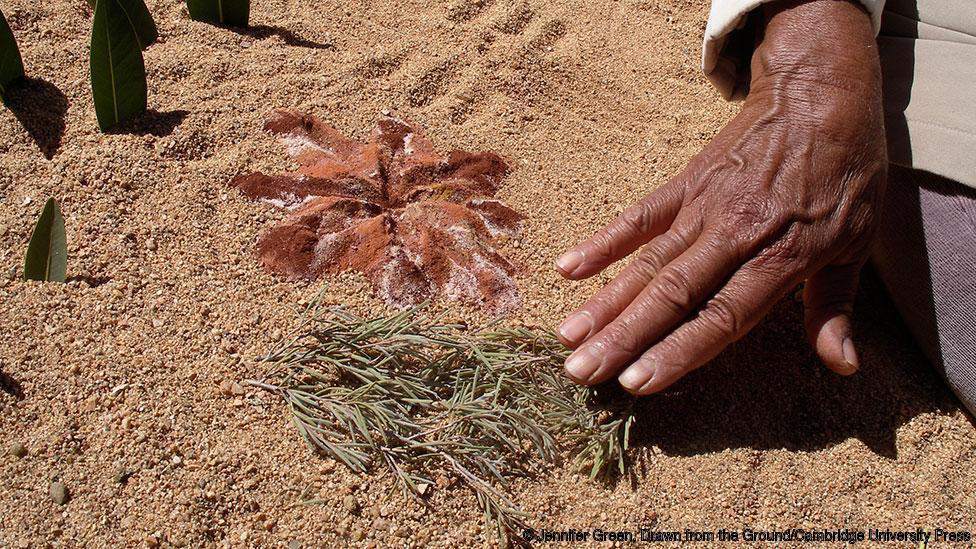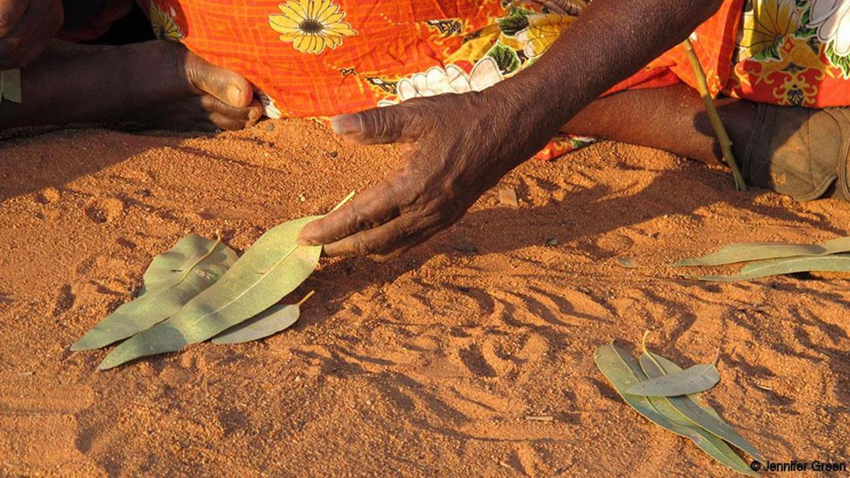


An online BBC article by David Robson - Are we hard-wired to doodle? - asks why we are compelled to doodle; with doodling, perhaps the story begins in the sands of the Australian desert.
For the Arandic, the Warlpiri, and other indigenous societies of the Australian desert, many conversations begin by carefully smoothing a patch of ground and clearing it of twigs and rocks. Over the next few minutes, little drawn figures quickly populate the rich red sand, as they tell tales of spirits, their ancestors' history, or simply news about the neighbours. Once the story is over, the ground is wiped clean, allowing the designs to 'go back to rest' in the soft earth.
The combination of drawn symbols and gestures are so eloquent that some linguists have even claimed that entire narratives could be relayed without the storyteller opening their mouth. Jennifer Green at the University of Melbourne has been researching this, in light of why humans draw, expressing through pictures, and employing graphic languages.

A sand story 'stage set' with leaf characters and fire pit, with Veronica Perrurle Dobson, Emily Gap, Australia. Image: Jennifer Green/Cambridge University Press)
Cognitive science now studies drawing and doodling as well fine art; everyday scribbles do serve important functions. One study has found, for instance, that far from being a distraction, doodling can prevent our minds from wandering into daydreams about the past or future, boosting concentration and memory.
Drawing can be thought of as a more innate trait: a form of language. Neil Cohn, at the University of California, San Diego, observes that drawings can have their own repeated vocabulary and grammar. Similar neural regions kick into gear when we view a comic strip as when we read a written sentence. All of which suggests that our urge and ability to draw should be considered alongside other linguistic skills.
For this reason, he has been working with Green on the Australian sand drawings. Green's recent book 'Drawn from the Ground' details the way these languages combine drawing, gestures, hand-signs and speech to form a single communication system. As Green points out, the sand stories are mostly told by the women of the societies, although men may also use drawn symbols in certain contexts. And even if the method of production has changed, they are still very much a central part of the people's identity.
In general, objects are depicted in the ways they would naturally make marks in the sand. So a person is pictured as a U shape - the shape we make when sitting cross-legged. Other drawn symbols in the vocabulary include broken circles to represent a cave, spirals and circular shapes to depict bushes and trees, and stars of radiating lines to represent fire, based on the criss-crossing of the burning wood.
Pictures can be combined into compound structures - a small U inside a U represents a child on a mother's lap. Specific hand signs performed above the drawings can represent styles of movement, for example, as well as certain animals such as birds that wouldn't leave an imprint on the ground. Such complex rules all helped confirm what Cohn had long expected - pictures can evolve many of the characteristics of language.

A Western Desert story-teller uses leaves as part of the narrative. Image: Jennifer Green
What of the origins of drawing? Researchers such as Michael Arbib at the University of Southern California have begun to consider that gesture and hand signs may have developed before speech, partly because other apes find it much easier to master gestures and sign languages, whereas they can never speak. Given his findings, Cohn suspects that we should add sand drawings to those early proto-languages. He imagines a situation where our ancestors were trying to communicate about a hunt, and so started copying animal tracks in the sand or soil as they discussed the best strategy.
Does this help us reassess cave paintings, which probably came much later in evolutionary history. In the past, some people have tried to read them as masterpieces along the lines of western art, where a painting is produced by an isolated genius and left for posterity. If you look at the fleeting narratives of the Australian desert, however, it is just as possible that the drawings were constructed for active, real-time storytelling. Cohn believes that cave paintings should be seen as communication from an individual who is speaking and drawing in real time, whether it was a ritual or telling a story.
Moreover, a linguistic view of drawing might also explain our behaviour today, including our instinct for doodling in the margins. Perhaps we are hard-wired to communicate in as many ways as possible and our environment determines which path becomes more dominant.
And the future? Australian sand narratives may be affected by new technology - the capacity to visualise stories has apparently made an amazing transition with the advent of iPads.
Comment
by Bradshaw Foundation
Monday 30 May 2022
by Bradshaw Foundation
Wednesday 19 January 2022
by Bradshaw Foundation
Thursday 06 January 2022
by Bradshaw Foundation
Monday 06 December 2021
by Bradshaw Foundation
Monday 29 November 2021
by Bradshaw Foundation
Monday 25 October 2021
by Bradshaw Foundation
Monday 12 July 2021
by Bradshaw Foundation
Monday 24 May 2021
by Bradshaw Foundation
Tuesday 20 April 2021
by Bradshaw Foundation
Thursday 01 April 2021
by Bradshaw Foundation
Tuesday 23 February 2021
by Bradshaw Foundation
Thursday 14 January 2021
by Bradshaw Foundation
Friday 18 December 2020
by Bradshaw Foundation
Sunday 06 December 2020
by Bradshaw Foundation
Thursday 26 November 2020
by Bradshaw Foundation
Wednesday 07 October 2020
by Bradshaw Foundation
Monday 30 May 2022
by Bradshaw Foundation
Wednesday 19 January 2022
by Bradshaw Foundation
Thursday 06 January 2022
by Bradshaw Foundation
Monday 06 December 2021
by Bradshaw Foundation
Monday 29 November 2021
by Bradshaw Foundation
Monday 25 October 2021
by Bradshaw Foundation
Monday 12 July 2021
by Bradshaw Foundation
Monday 24 May 2021
by Bradshaw Foundation
Tuesday 20 April 2021
by Bradshaw Foundation
Thursday 01 April 2021
by Bradshaw Foundation
Tuesday 23 February 2021
by Bradshaw Foundation
Thursday 14 January 2021
by Bradshaw Foundation
Friday 18 December 2020
by Bradshaw Foundation
Sunday 06 December 2020
by Bradshaw Foundation
Thursday 26 November 2020
by Bradshaw Foundation
Wednesday 07 October 2020
Friend of the Foundation











